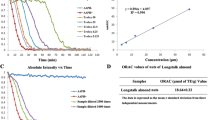Abstract
The seeds ofVigna aconitifolia andVigna vexillata were analysed for proximate composition, minerals, seed protein fractions, amino acids, fatty acids, and antinutritional factors. Both the pulses were found to be rich sources of proteins and minerals like Ca, Mg, Fe, Zn, and Mn.Vigna aconitifolia seeds exhibited fairly high levels of crude lipid. The most limiting essential amino acids in both the pulses were the sulphur-amino acids, cystine, and methionine. Threonine inV. aconitifolia and phenylalanine and tyrosine inV. vexillata occurred in higher quantities when compared with WHO/FAO requirement pattern. Oleic acid and palmitic acid inV. aconitifolia and linoleic acid and palmitic acid inV. vexillata lipids were found to be the predominant fatty acids. The tannin content of both the pulses was negligible compared with the domesticated legumes. The other antinutritional factors like total free phenols, L-DOPA and haemagglutinating activity were also analysed/assayed.
Similar content being viewed by others
References
AOAC (1970) Official Methods of Analysis, 11th ed. Washington, DC: Association of Official Analytical Chemists.
Arulmozhi M, Janardhanan K (1992) The biochemical composition and nutritional potential of the tribal pulse,Mucuna monosperma DC. ex Wight. Plant Foods Hum Nutr 42: 45–53.
Babu CR, Sharma SK, Johri BM (1985) Leguminosae-Papilionoideae: Tribe — Phaseoleae. Bull Bot Surv India 27: 1–28.
Brain KR (1976) Accumulation of L-DOPA in cultures fromMucuna pruriens. Plant Sci Letts 7: 157–161.
Bray HG, Thorne WV (1954) Analysis of phenolic compounds. Meth Biochem Anal 1: 27–52.
Burns RR (1971) Methods for estimation of tannin in grain Sorghum. Agron J 63: 511–512.
Carnovale E, Lugaro E, Marconi E (1991) Protein quality and antinutritional factors in wild and cultivated species ofVigna spp. Plant Foods Hum Nutr 41: 11–20.
Dickman SR, Bray RH (1940) Colorimetric determination of phosphate. Ind Eng Chem Anal Ed 12: 665–668.
Folch J, Lees M, Solane-Stanley GH (1957) A simple method for the isolation and purification of total lipids from animal tissues. J Biol Chem 226: 497–506.
Gunjatkar N, Vartak VD (1982) Enumeration of wild legumes from Pune district, Maharashtra State. J Econ Tax Bot 3: 1–9.
Humphries EC (1956) Mineral composition and ash analysis. In Modern Methods of Plant Analysis, Vol. 1, K Peach and MV Tracey, eds. Berlin: Springer Verlag, pp. 468–502.
Issac RA, Johnson WC (1975) Collaborative study of wet and dry techniques for the elemental analysis of plant tissue by Atomic Absorption Spectrophotometer. JAOAC 58: 436.
Jambunathan R, Singh U (1980) Studies on Desi and Kabuli chickpea (Cicer arietinum) cultivars. 1. Chemical composition. In Proceedings of the International workshop on Chickpea Improvement. ICRISAT, Hyderabad, India, 28 February – 2 March 1979.
Janardhanan K, Lakshmanan KK (1985) Studies on the tribal pulse,Mucuna utilis: Chemical composition and antinutritional factors. J Food Sci Technol 22: 369–371.
Khan AM, Jacobsen I, Eggum OB (1979) Nutritive value of some improved varieties of legumes. J Sci Food Agric 30: 395–400.
Kuzayli MV, Cowan JW, Sabry ZI (1966) Nutritive value of middle eastern food stuffs. II. Composition of pulses, seeds, nuts and cereal products of Lebanon. J Sci Food Agric 17: 82–84.
Liener IE (1976) Phytohaemagglutinins (Phytolectins). Ann Rev Plant Physiol 27: 291–319.
Lowry OH, Rosebrough NJ, Farr AL, Randall RJ (1951) Protein measurement with folin phenol reagent. J Biol Chem 193: 265–275.
Mary Josephine R, Janardhanan K (1992) Studies on chemical composition and antinutritional factors in three germplasm seed materials of the tribal pulse,Mucuna pruriens (L.) DC. Food Chem 43: 13–18.
Metcalfe LD, Schemitz AA, Pelka JR (1966) Rapid preparation of fatty acid esters from lipids for gas chromatographic analysis. Anal Chem 38: 514–515.
Muller HG, Tobin G (1980) Nutrition and Food Processing. London: Croom Helm Ltd.
Murray DR (1979) The seed proteins of Kowhai,Sophora microphylla AIT. Z Pflanzenphysiol 93; 423–428.
Nowacki E (1980) Heat stable antinutritional factors in leguminous plants. in: RJ Summerfield and AH Bunting (eds.) Advances in Legume Science. Royal Botanic Gardens, Kew, Richmond, Surrey, UK, pp. 171–177.
NRC/NAS (1980) National Research Council Committee on Dietary Allowances. Recommended Dietary Allowances, 9th ed. Washington, DC: National Academy of Sciences Press.
Nwokolo E (1987) Nutritional evaluation of pigeonpea meal. Plant Foods Hum Nutr 37: 283–290.
Omogbai FE (1990) Lipid composition of tropical seeds used in the Nigerian diet. J Sci Food Agric 50: 253–255.
Osborne DR, Voogt P (eds.) (1978) Calculation of calorific value. in: The Analysis of Nutrients in Foods. New York: Academic Press, pp. 239–240.
Pawar VD, Ingle UM (1988) Functional properties of raw and cooked moth bean (Phaseolus aconitifolius Jacq) flours. J Food Sci Technol 25: 186–189.
Rajaram N, Janardhanan K (1990) Chemical analysis and nutritional evaluation of certain under exploitedVigna spp. Food Sci Nutr 42: 213–221.
Rajaram N, Janardhanan K (1991) The biochemical composition and nutritional potential of the tribal pulse,Mucuna gigantea (Willd.) DC. Plant Foods Hum Nutr 41: 45–51.
Rao PU, Belavady B (1979) Chemical composition and biological evaluation of Goa beans (Psophocarpus tetragonolobus) and their tubers. J Plant Foods 3: 169–174.
Rao PV, Deosthale YG (1982) Tannin content of pulses, varietal differences and effects of germination and cooking. J Sci Food Agric 33: 1013–1016.
Singh U, Subrahmanyam N, Kumar J (1991) Cooking quality and nutritional attributes of some newly developed cultivars of chickpea (Cicer arietinum). J Sci Food Agric 55: 37–46.
Ukhun ME (1984) Fatty acid composition and oxidation of cowpea (Vigna unguiculata) flour lipid. Food Chem 14: 35–43.
WHO/FAO (1973) FAO Energy and protein requirements. Report of Joint FAO/WHO Ad hoc Expert Committee, published by FAO/WHO, Rome, 1973.
Author information
Authors and Affiliations
Rights and permissions
About this article
Cite this article
Siddhuraju, P., Vijayakumari, K. & Janardhanan, K. Chemical analysis and nutritional assessment of the less known pulses,Vigna aconitifolia (Jacq.) Marechal andVigna vexillata (L.) A. Rich.. Plant Food Hum Nutr 45, 103–111 (1994). https://doi.org/10.1007/BF01088467
Received:
Accepted:
Issue Date:
DOI: https://doi.org/10.1007/BF01088467




